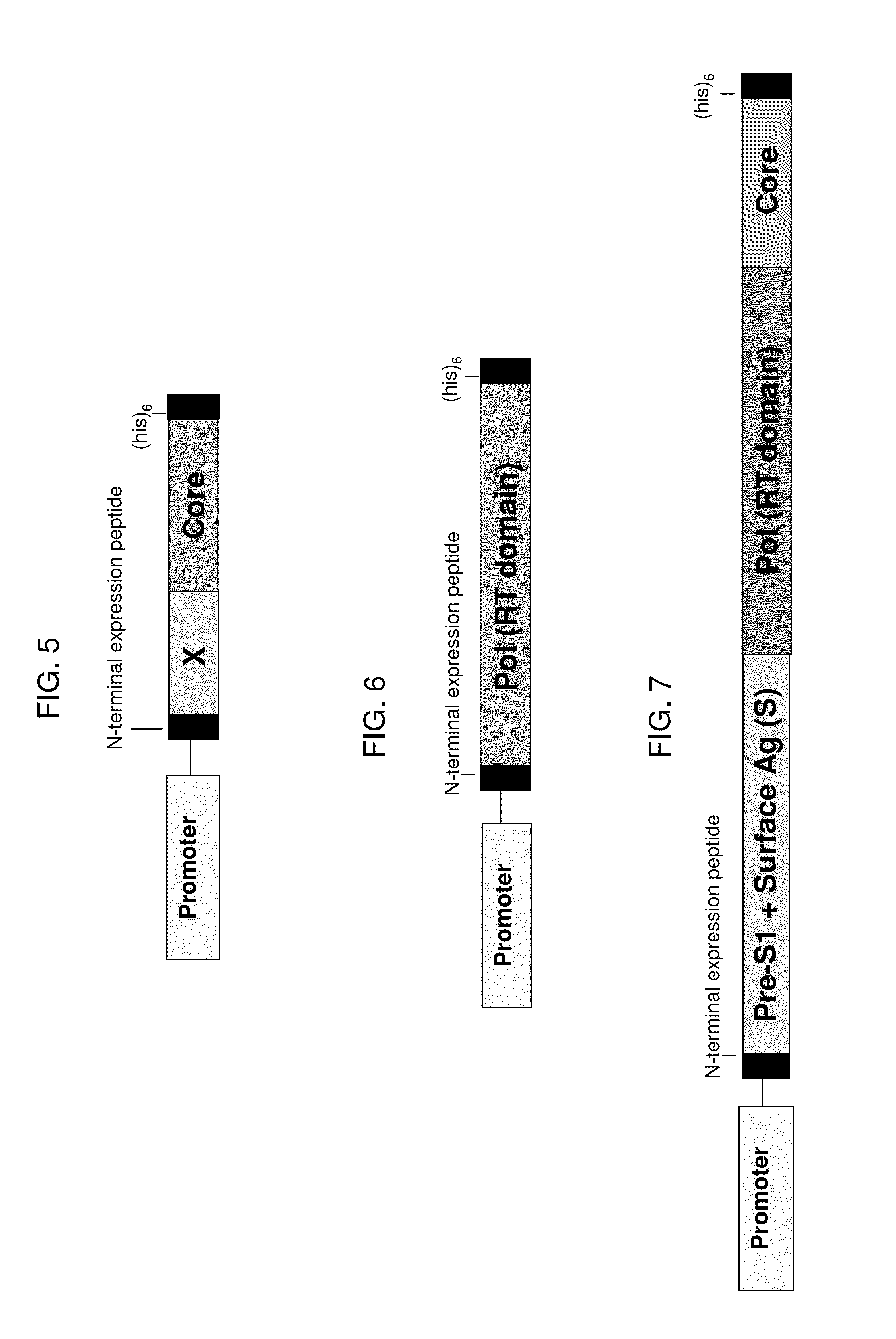Compositions and Methods for the Treatment or Prevention of Hepatitis B Virus Infection
- Summary
- Abstract
- Description
- Claims
- Application Information
AI Technical Summary
Benefits of technology
Problems solved by technology
Method used
Image
Examples
Example
[0197]Example 7 also describes a fusion protein that is similar in design to the fusion protein represented by SEQ ID NO:34, but that is based on a consensus sequence for HBV genotype B. This fusion protein, which is also schematically illustrated in FIG. 2, is a single polypeptide with the following sequence elements fused in frame from N- to C-terminus, represented by SEQ ID NO:114 (optional sequences that are not HBV sequences are not included in the base sequence of SEQ ID NO:114, but may be added to this sequence as in the construct described in Example 7): (1) optionally, an N-terminal peptide that is a synthetic N-terminal peptide designed to impart resistance to proteasomal degradation and stabilize expression represented by SEQ ID NO:37, which may be substituted by an N-terminal peptide represented by SEQ ID NO:89, SEQ ID NO:90, or another N-terminal peptide suitable for use with a yeast-based immunotherapeutic as described herein; (2) optionally, a linker peptide of from o...
Example
[0209]As described in more detail in Example 5, to construct an HBV surface antigen segment, a full-length large (L) surface antigen protein from HBV genotype C was reduced in size by truncation of the N- and C-terminal sequences, while maximizing the inclusion of known MHC T cell epitopes, using the prioritization for inclusion of T cell epitopes associated with acute / self-limiting infections. The resulting surface antigen segment is represented by SEQ ID NO:97.
[0210]To construct the segment of the fusion protein comprising HBV polymerase (see Example 5), substantial portions of a full-length polymerase from HBV genotype C were eliminated by focusing on inclusion of the active site domain (from the RT domain), which is the most conserved region of the protein among HBV genotypes and isolates, and which includes several sites where drug resistance mutations have been known to occur. The HBV polymerase segment was designed to maximize known T cell epitopes, using the prioritization s...
Example
[0222]Example 8 describes a fusion protein that contains sequences from HBV surface antigen, core protein, polymerase and X antigen, where the sequences were derived from segments of the fusion proteins represented by SEQ ID NO:110 and SEQ ID NO:118, and where the fusion protein utilizes a different order of fusion segments as compared to SEQ ID NO:110. This antigen is based on a consensus sequence for HBV genotype D; however, it would be straightforward to produce a fusion protein having a similar overall structure using the corresponding fusion segments from the fusion proteins represented by SEQ ID NO:107 or SEQ ID NO:112 (genotype A), SEQ ID NO:108 or SEQ ID NO:114 (genotype B), SEQ ID NO:109 or SEQ ID NO:116 (genotype C), or using the corresponding sequences from a different HBV genotype, sub-genotype, consensus sequence or strain. In this example, yeast (e.g., Saccharomyces cerevisiae) were engineered to express this fusion protein under the control of the copper-inducible pro...
PUM
| Property | Measurement | Unit |
|---|---|---|
| Fraction | aaaaa | aaaaa |
| Fraction | aaaaa | aaaaa |
| Immunogenicity | aaaaa | aaaaa |
Abstract
Description
Claims
Application Information
 Login to View More
Login to View More - R&D
- Intellectual Property
- Life Sciences
- Materials
- Tech Scout
- Unparalleled Data Quality
- Higher Quality Content
- 60% Fewer Hallucinations
Browse by: Latest US Patents, China's latest patents, Technical Efficacy Thesaurus, Application Domain, Technology Topic, Popular Technical Reports.
© 2025 PatSnap. All rights reserved.Legal|Privacy policy|Modern Slavery Act Transparency Statement|Sitemap|About US| Contact US: help@patsnap.com



